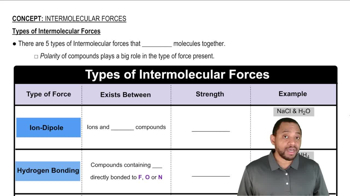Here are the essential concepts you must grasp in order to answer the question correctly.
Intermolecular Forces
Intermolecular forces are the attractive forces between molecules that influence physical properties such as boiling and melting points. These forces include hydrogen bonding, dipole-dipole interactions, and London dispersion forces. Understanding these interactions is crucial for predicting the behavior of substances in different states and conditions.
Recommended video:
Intermolecular vs Intramolecular Forces
Types of Intermolecular Forces
Different types of intermolecular forces arise from the nature of the molecules involved. For example, hydrogen bonding occurs in molecules with N-H, O-H, or F-H bonds, while dipole-dipole interactions occur between polar molecules. London dispersion forces are present in all molecules, regardless of polarity, and are particularly significant in nonpolar substances.
Recommended video:
Types of Intermolecular Forces
Molecular Polarity
Molecular polarity is determined by the distribution of electron density within a molecule, which affects its intermolecular interactions. Polar molecules have a net dipole moment due to uneven electron sharing, while nonpolar molecules have symmetrical charge distributions. Identifying the polarity of each compound is essential for determining the types of intermolecular forces present.
Recommended video:
 Verified step by step guidance
Verified step by step guidance


